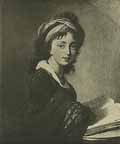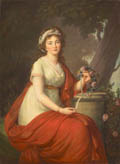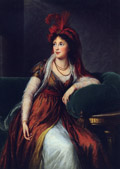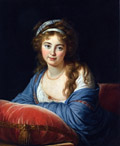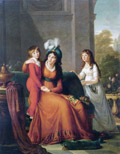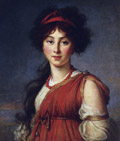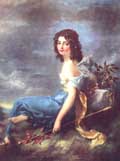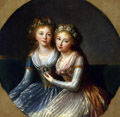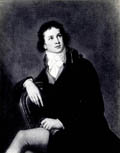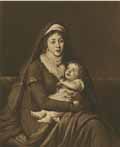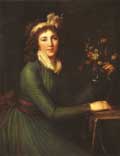|
Reprinted from the Gazette des Beaux Arts, July-August 1967
Vigée Le Brun's Home Page | Index to Art Pages
Vigée Le Brun's Gallery | Vigée Le Brun Biographies
The Russian Portraits Of Madame Vigée Le Brun
BY Lada Nikolenko
Russian Portrait List | Portraits of Women | Portraits of Men
Madame Vigée Le Brun spent six years in Russia and seemed to have loved it sincerely. Surely she exaggerated when she wrote that one never sees a drunken man there, or that all Russian people lived very happily under the rule of Catherine II but, on the whole, she experienced there much warm-hearted hospitality and her talent had been greatly appreciated. According to her memoirs. she entered St. Petersburg the 25th of July. She remained there until the 15th of October 1800 when she left for Moscow. In the middle of March 1801 she returned to St. Petersburg to leave it some time later in the same year. "On crossing the Russian border I burst into tears" writes the artist "I wanted to retrace my Journey and I vowed I would come back to those who had for so long heaped tokens of friendship and devotion upon me, and whose memory is ever in my heart " . But she was never to see again the country she considered her second motherland.
Among her Russian friends who were many, wealthy, influential and well-
educated, the family stroganov played a prominent part and she painted several portraits of its members even before she came to Russia. Mme Vigée Le Brun also Counted among her friends on the banks of Neva the strikingly beautifulPrincess Catherine Dolgorouky (Fig.1), and her still charming mother Princess Maria Bariatinsky . Being lovely herself, Mme Vigée Le Brun had a great weakness for good looks of other people and she found them abounding at the Russian court and in the houses of the Russian aristocracy still fresh in its first flowering of vitality, zest for life and all the enchantment of its almost amorous encounter with Western culture. In a word, Elisabeth Vigée Le Brun met the best representatives of a society which in one generation was to produce Poushkine.
In her list of portraits done in Russia Vigée Le Brun counts forty-five works but, gathered from catalogues, letters and memoirs, her Russian portraits amount to sixty-seven which is probably still incomplete. Some of them are hard to trace, and are lost for ever in the aftermath of the revolution and civil war in Russia. Some were taken away by Russian emigrants and later sold usually losing their original names, too Iong and too strange for their Western buyers. In fact, most of the portraits of Russian sitters painted by French, Italian or Scandinavian artists, changed their identity abroad.
Such was the fate of one of the most picturesque and little known portraits of Russian sitter painted by Vigée Le Brun in St. Petersburg in the 1790s - that of Princess Eudocia Ivanovna Galitzine nee Izmaillov (Fig. 2). Although it is signed and obviously painted with inspiration and fantasy, it is not metioned by the artist either in her list or in her memoirs. This portrait of a lovely dark-haired woman walking with a basket of flowers on her head against an Italian landscape, was shown at the large Exhibition of Russian portraits at the Taurida Palace in St. Petersburg in 1905 . Baron Wrangell in his article "Foreign Artists in Russia" gives an enthusiastic description of this portrait of Princess Galitzine "walking languid and charming, holding a basket of flowers on her head". The sitter of this Italianate portrait was indeed a remarkable woman.. A celebrated beauty, an eccentric, a mistress of a salon a mathematician and a great patriot. She was known in St. Petersburg, under the name of "Princess de Minuit"" because a gypsy once foretold her death in her bed during night hours and all the receptions in her elegant house were held very late at night to prevent her from falling asleep during the span of time she considered fatal. Her beauty was of the classical southern type, with dark locks and eyes and Languorous expression. Young Poushkine who frequented her salon, admired her very much, and one of her friends, Alexandre Turgenev writes in one is letters that "when she is not a Pythia on a tripod but a simple woman in her armchair, she is delightful". One gathers from these words that the lovely Princess could be sometimes carried too far by her outbursts of mystical inspiration.
This portrait , formerly in the Stroganov Collection, was sold at Berlin in 1931. The slightly changed version of it had been sold in Paris in 1928, as the one of Mme Nigris, the artist's daughter (Fig 3), painted in Italy. The background misled the attributers. It had been painted in Russia and Mme Vigée Le Brun has used it for one of those "various landscapes, oils and crayons done at Naples", listed in her memoirs. Both Mlle Le Brun and Princess Galitzine were born in 1780. but at the time the artist was in Italy they were still girls of thirteen. The portrait represents a very young but still grown up woman, the Princess being seventeen or eighteen when Mme Vigée Le Brun painted her in Russia in the late 1790s. Unfortunately, the whereabouts of these portraits are unknown. Its unusual sitter had been also portrayed twice by other artists as a "Vestale" by Yegorov (Tretyakov Gallery) and as a smiling salon beauty by Grassi (Museum of Russian Literature, Leningrad).
Mine Vigée Le Brun had also painted a portrait of the elder sister of Princess Galitzine, Countess Irina Ivanovna Worontzov (Fig. 4) (spelt "Voranxoff" in her list). The early widowed Countess seemed to be very different from her brilliant sister but nevertheless much admired and respected for her upright character, her good sense in household matters and the excellent education of her only son. Not celebrated for her beauty, but sharing the literary tastes of many of her friends and contemporaries, she is painted with an open volume of Racine on the table in front of her. She is dressed in a simple empire gown and a shawl and the traditional scarf wrapped negligently around her head lets her curly hair fall upon her neck. The portrait is signed and dated 1797 and its present whereabouts are equally unknown.
Most of the Russian portraits of Mme Vigée Le Brun are marked by a kind of attractive simplicity, a cozy feeling of being at ease and not posing which is perhaps, speaking of Russian portrait painting in general one of its most remarkable characteristics. Indeed, a lady painted by Borovikovsky of Kiprensky, in a white empire gown in a midst of a green park, is always a little less romantic and elegant than her Western contemporary, but almost invariably more natural, nonchalant and unpretentious. Of course simplicity and sensibility were already fashionable before Mme Vigée Le Brun came to Russia, and she had painted Marie-Antoinette and other ladies in plain dresses and comfortable attitudes, and first introduced this to Russian society. But in the hospitable warm atmosphere of Russian homes this trend had been carried still further in the way of relaxation and many of Mine Vigée Le Brun's portraits reflect this mood.
However, in some cases, she returned to more theatrical representations, e.g.
the portrait of the lovely Princess Dolgorouky (Fig. 1) whom she painted by her own request as "Sybil" repeating with slight changes, her celebrated portrait of Lady Hamilton. The taste of the vanishing 18th century also manifests itself again in such portraits as one of Countess Marie Potocka (Fig. 5) painted in St. Petersburg in I795 reclining on a sofa with a dove in her hand or in a portrait of one of the nieces of Potemkin, Princess Tatiana Youssotipov (Fig. 6), seated in a park (Cat. 17), one elbow resting on a pedestal, holding a Wreath in her hands and herself crowned with flowers. Otherwise her female sitters are represented seated cozily on one of those long broad divans the artist remembered with such pleasure, leaning on a velvet cushion like another Princess Galitzine (Anna Alexandrovna) (Fig. 7), the so-called "Princess Bauris" whose large portrait is now at the Baltimore Museum of Art. To the same group of comfortable images with a velvet cushion belongs the portrait of Countess Ecaterina Vladimirovna Apraxine whose stern beauty had earned her the nick-name "Venus en courroux" when she visited Paris and whom Poushkine used as a prototype for his "Pique Dame" called "Venus Moscovite" in her youth. For the actual old "Pique Dame" of his story he used the much-dreaded mother of Countess Apraxine thus merging the two women, the old and the young, into one personality. However, Mme Vigée Le Brun succeeded in presenting the young woman in a manner and not at all "en courroux".
The wife of a counsellor Kolitchev, Natalia is painted in the same
way as Countess Irina Worontzov (Fig. 4), in a plain long sleeved dress and shawl, with a book opened before her on a familiar velvet cushion. The adorable Countess Catherine Scavronska (Fig. 8), another lovely niece of Potemkin and wife of the Russian Ambassador in Naples, whom Mme Vigée Le Brun first met, admired and painted in Italy, is again represented facing the spectator and folding her arms wrapped in a shawl upon a cushion.
Those Iong-sleeved, high waisted dresses and shawls could be seen on portraits done already in France and Austria, before the visit to Russia, but the way those shawls are wrapped around the arms, warmly hiding the hands, conveys that attitude of people living in a colder climate. The contrast with diaphanous Greek chitons of more romantic representations just as the descriptions of a cold winter and a hot summer contrast on the paces of Mme Vigée Le Brun's memoirs.
Such simple attire and somewhat chllly pose are shown in the portrait of Princess Anne Belosselsky-Belosersky , a rich heiress married to the Russian Ambassador in Dresden and Turin. In the opinion of one of her contemporaries, Prince Paul Dolgorouky, she had "I'air d'unee femme de chambre endimanchee"" which is somehow reflected in her portrait by Mme Vigée Le Brun. Other ladies wear a similar costume with more grace and elegance in their likenesses, but she is attractive in her simplicity.
Mme Vigée Le Brun liked to paint ladies holding their babies in their arms or in their lap. Countess Sofia Stroganov (Fig. 9), her friend and patron in Russia, is shown with her little son. She was one of the most outstanding women of her time - well-educated and lovely, but suffering from poor health which deprived her much too early of her charming looks which Mme Vigée Le Brun succeeded in retaining on canvas. The other beauty Princess Ecaterina Meshikov, is seated before a clavichord, with her child in her lap; Countess Ecaterilia Somoilov (Fig. 10) is painted full length with two of her children; another Princess Galitzine [Princess Menshikova] (Fig. 11) presses her little nephew tenderly to her bosom.
The lack of reference material on Mme Vigée Le Brun's Russian portraits has sometimes led to misunderstandings. The Columbus Gallery of Fine Arts in Columbus, Ohio, acquired some years ago a lovely portrait painted by Mme Vigée Le Brun in Moscow in 1801. It was not listed by the artist and was only mentioned briefly in her memoirs. The description of this portrait given in a small Russian catalogue, of an Exhibition of Historical Portraits presented in St. Petersburg in 1870, had escaped the notice of Mme Vigée Le Brun's biographers. The sitter was a young and pretty Varvara Narishkine (Fig. 12) whose charm Mme Vigée Le Brun tried to enhance by a kind of a classical costume keeping the originality of the face happily untouched by this banal frame. The portrait was published in the sale catalogue of Oscar B. Cintas collection of Old Masters in New York as that Princess Tufiakin (Fig. 13) . The latter portrait was described by the artist in her memoirs and was begun in Moscow in 1801 and later taken to France Mme Vigée Le Brun finished it under those "done in Paris after returning. Mme Vigée Le Brun was very much impressed by the melancholy beauty of the young Princess Tufiakin who died prematurely in 1802. She painted her, according to her own descriptions "Iris" seated on some clouds, with a billowy scarf about her . This description alone excludes the possibility of confounding the portrait of Princess Tufiakin with that of Varvara Narishkine, now at the Columbus Gallery of Fine Arts. The widowed Prince Tufiakin lived in Paris and kept the portrait of his wife in his house. Somewhere, in France, the likeness of Princess Tufiakin, with her clouds and scarves, is preserved simply as a painting by Mme Vigée Le Brun.
Despite the temporary displeasure of Catherine II on account of a portrait of two of her granddaughters, Alexandra and Elena (Fig. 14), painted by Mme Vigée Le Brun locked affectionately together, with a miniature portrait of their grand mother in their hands, and styled by the Empress in a letter to Grimm as deux singles accroupis qui grimacent a cote l un de l autre", the artist executed attractive portraits of other members of the Imperial family: of Grand Duchess Elisabeth Alexeevna, wife of the future Alexander I and of Grand Duchess Maria Fedorovna wife of Paul. Catherine the Great's son, Who was soon to become an Empress, The dynasty of Romanov upheld the ancient Byzantine tradition, adopted by The Moscovite Tzars, to choose their brides for their beauty, and Mme Vigée Le Brun was able to indulge in her love for spectacular looks while painting obligatory official portraits. She did not need to flatter.
The sudden death of Catherine II in I796, prevented the artist front painting her portrait, but she executed the pastel bust portraits of Alexander and Elisabeth Alexeevna which she later finished in Dresden.
Young Russian noblemen painted by Mme Vigée Le Brun painted are, in most cases, also handsome and elegant. Count Grigory Tchernyshev (Fig. 15), a young diplomat, painted again in Vienna. in a black domino and a mask in his hand, shows a lively expression of someone who has just recognized a friend in a crowd around him. An amateur of French verses and plays, he loved gay society life and amusements of balls and masquerades and the artist has captured this mood in his portrait. She continued in this line in her Petersburg and Moscow portraits. Count Paul Stroganov (Fig. 16), friend of Alexander I and husband of the charming Countess Sofia Vladimirovna Stroganov (Fig.17), also painted by Mme Vigée Le Brun, is represented in an easy and elegant pose. seated informally on a chair with a high back. holding his gloves in his left
hand and showing an expression of a person caught in the midst of an animated conversation. The similar informal pose, with one elbow over the back of the chair, is introduced again in the portrait of Baron (there were two branches of the Strozanov, family - the Counts and the Barons) Alexander Stroganov, (Fig. 18), the so-called "petit Baron" on account of his effeminate beauty. Prince Ivan Bariatinskv (Fig.19), an anglicized land owner and an able administrator of his large estates, turns his handsome curly hair towards the onlookers, painted half length, wrapped in an embroidered velvet cloak. Mme Vigée Le Brun had painted him twice and both portraits were the Taurida Palace Exhibition which presented, just before the fall, the four generations of the Russian nobility.
Another romantic appearance in a velvet cloak is Prince Sergey Gargarine
(Fig. 20) painted in Moscow in 1801. Director of Imperial Theaters, he was famous for his good looks and decent treatment of actors and especially young
actresses whom he always he always approached in a very polite official way-an attitude greatly deplored by Mlle Mars during her stay, in Russia. Mme Vigée Le Brun enjoyed painting all these attractive young faces which needed no embellishment and made them just as smooth and agreeable as those of her female models.
When her model was not especially goo . Mme Vigée Le Brun emphasized her or his intellectual or sympathetic qualities. >Princess Maria Kotchubey is portrayed sketching in a large album placed on her knees: Baroness Anna Stroganov (Fig. 21)arranging flowers in a vase the other portrait of her, now at the Hermitage, shows her with a child in her arms. The oval portrait of her husband, Count Grigory Alexandrovich Stroganov (Fig. 22), painted Vienna in 1793, is now also at the Hermitage and was presented at the Exhibition of French Painting in the Museums of Leningrad and Moscow, shown recently, in France.
Some portraits are preserved only in miniatures done after them Mme Elisabeth Demidov, nee Baroness Stroganov (Fig.23), was painted in Russia. Her name heads the list of Russian portraits compiled by Mme Vigée Le Brun. The portrait, however, seems to be lost. The miniature reproduced in "Les Portraits Russes" by the Grand Duke Nicolas Michailovich " might be eventually, a copy of the lost portrait by . Mme Vigée Le Brun. The pretty and extravagant Mme Demidov was also painted twice by Greuze, as a Bacchante and as a Penitent Magdalen, which reveals her taste for such a genre of portrait. The miniature in question shows her wearing a white turban over her loosened hair and revealing coquettishly one of her bare breasts a feature almost unthinkable among the representations of a Russian lady but characteristic of this eccentric Woman.
The other suggestion of a miniature done after a lost portrait by Vigée Le Brun is the portrait of Grand Duchess Anna Fedorovna, the unhappy
consort of Grand Duke Constantine, brother of Alexandre I, from whom she was later divorced. Mme Vigée Le Brun listed the portraits as "Grand Duchess Anne, two portraits half length" and praised the young woman's charm and prettiness in her Memoirs. The portraits of the Grand Duchess with a miniature representing Catherine II in her hands, reproduced in "Les Portraits Russes" of Grand Duke Nicholas Michailovich as a work of Mme Vigée Le Brun, was undoubtedly painted by Borovikovsky. The miniature depicts the Grand Duchess in a white dress and dark shawl under which her hands are crossed. Although done by an amateur, it retains something of a smiling charm of the lost portrait.
Also the portrait of Princess Eudocia Galitzine (Fig. 2), " Princess de Minuit" was copied in miniature (without the Italian background landscape) with small changes and not very skillfully. Another portrait, Another portrait, known only via a miniature, is that of Mme Aglae Davidoff, a Frenchwoman married to a Russian general, and courted by Poushkine. Mme Vigée Le Brun mentions her portrait among those "done in Paris after returning", which suggests that it has been begun in Russia and finished in France.
Despite the marked predominance of portraits of beautiful women, handsome men and sweet children. Mme Vigée Le Brun left some excellent studies of elderly men painted in Russia. One of the most characteristic among them is the portrait of the old Count Alexey Orlov Tchemensky, the famous champion of Catherine the Great in her fight for power and her wars. Mme Vigée Le Brun painted him without any paraphernalia of a hero, simply as an old man in a red house robe with a large fur collar, and a white kerchief around his neck. Nothing diverts attention from his crafty face. This portrait existed before the revolution in Russia in two variations, full length and bust length painted in an oval.
The portrait of the marshal Count Ivan Petrovich Soltykov, governor of Moscow, whom Mme Vigée Le Brun painted there in 1801, must have possessed the same quality of psychological insight. baron Wrangell in his article "Foreign Artists in Russia" mentions the sly grin of the old marshal , and also emphasizes the pompous man of Count Fedor Golovkine also painted by Mme Vigée Le Brun. Unfortunately it has not been possible to trace the whereabouts of these two portraits of, at least find reproductions of them. At the time of the large Portrait Exhibition at the Taurida Palace, the likeness of Count Golovkine was the property of Kiev University. Maybe it is still there. The artist did not mention it in her list.
The following list of Mme Vigée Le Brun's portraits of Russian sitters comprises sixty seven names derived from her own list and memoirs as well as from the catalogues of exhibitions in Russia and from the dispersed collections. They are divided into two groups: Portraits of women and portraits of men both listed in chronological order according to their date of birth. Portraits of the Polish sitters painted in Russia are not included except that of princess Maria Potocka who later married Count Zubov and is sometimes referred to as Countess Zoubov. later she married Count Uvarov and was also portrayed under this name.
Vigée Le Brun's Home Page | Index to Art Pages
Vigée Le Brun's Gallery | Vigée Le Brun Biographies

|



